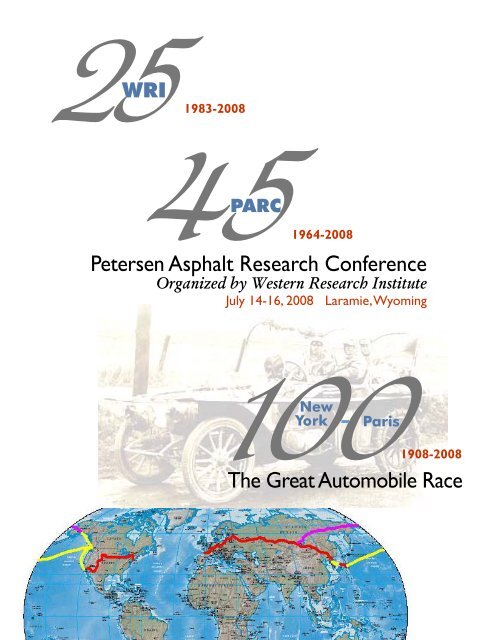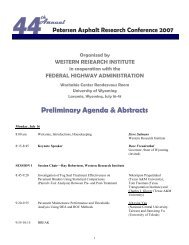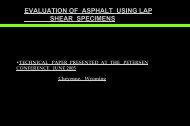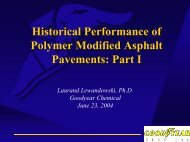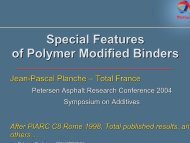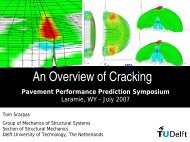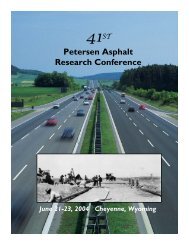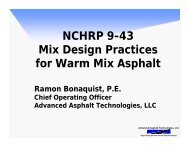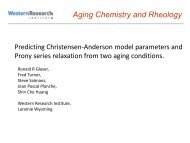Petersen Asphalt Research Conference 2008 Program
Petersen Asphalt Research Conference 2008 Program
Petersen Asphalt Research Conference 2008 Program
You also want an ePaper? Increase the reach of your titles
YUMPU automatically turns print PDFs into web optimized ePapers that Google loves.
July 14-16 Laramie, WyomingTuesday EveningCONFERENCE DINNERIvinson Mansion, 603 Ivinson AvenueSocial Hour andIvinson Mansion Tours 5:30Dinner 6:30The Laramie Plains Museum is housedin the Victorian mansion built by Laramietown father, Edward Ivinson.8:35-9:10 Effect of Temperature on the Moisture Susceptibility of Pedro RomeroHot-Mix <strong>Asphalt</strong>University of Utah;Kevin VanFrankUtah Dept. of Transportation;Jason Nielson University of Utah9:10-9:45 Update on TFHRC <strong>Research</strong>: The Effect of Moisture Terry Arnold, FHWA;on HMA Mixes Modified with Phosphoric AcidSusan NeedhamSES Group & Associates, LLC9:45-10:05 BREAK10:05-10:40 Polyphosphoric Acid (PPA) Modified <strong>Asphalt</strong> Binders: Cristian Clopotel andFactors of Influence on Rheological PropertiesCodrin DarangaUniversity of Wisconsin-Madison10:40-11:15 Polyphosporic Acid Modified <strong>Asphalt</strong> in Conjunction JV Martin Innophos;with Lime as an Antistripping agent: PerformancesG. Reinke MTE; T. Clyneof <strong>Asphalt</strong> Mixes used in MN Road Pavement TestMinnesota Dept. ofTrack―Preliminary ResultsTransportation; D. FeeICL-Performance Products11:15 CLOSING REMARKS7
PRACTICAL USE OF VECD ANALYSIS IN PAVEMENT DESIGNM. Emin Kutay (1), Nelson Gibson (2), Raj Dongré (3) and Jack Youtcheff (2)(1) SES Group & Associates; (2) FHWA; (3) DLSIThe Viscoelastic Continuum Damage (VECD) theory has gained wide acceptance in analysis of fatigue characteristics ofhot mix asphalt (HMA) pavements. VECD theory is capable of successfully modeling uniaxial behavior of HMA for avariety of temperatures and loading rates. Practical applications of VECD theory have also been proposed by a numberof researchers. Furthermore, VECD-based simulations have been shown to produce very good correlation with the fieldmeasurements such as the fatigue data from the Accelerated Loading Facility (ALF) at the Turner-Fairbank Highway<strong>Research</strong> Center (TFHRC). What is needed is a demonstration and discussion of the use of VECD (and possiblyVEPCD) for everyday pavement engineering and materials characterization. This presentation demonstrates the possibleuse of VECD (or VEPCD) in a future version of the Mechanistic Empirical Pavement Design Guide (MEPDG). Simulationsare used to show the applicability of VECD based damage calculations for pavement design.FORWARD AND INVERSE SELF-CONSISTENT MICROMECHANICS MODELOF AN ASPHALT CONCRETE MIXTURERong Luo and Robert L. LyttonTexas A&M UniversityA forward and inverse self-consistent micromechanics model has been developed for the asphalt concrete as a compositematerial consisting of three components: asphalt binder, aggregate and air. This model has been programmed usingMATLAB and been applied to the analysis of the viscoelastic properties of asphalt mixtures at different aging times. Theinverse process takes as input the volumetric composition of the mixture and the measured frequency-dependent bulkand shear properties of an asphalt mixture and a binder and extracts from them the bulk and shear properties of the aggregate.The forward process takes as input the frequency-dependent bulk and shear properties of the aggregate and binderand produces the frequency-dependent properties of the asphalt mixture. It has been demonstrated that the forward andinverse operations are in fact the inverse of each other and that the inferred aggregate properties are realistic. This modelprovides a technique to catalog the properties of aggregate and use them in a computerized determination of the combinationsof binders, aggregates and air to produce the desired properties of asphalt mixtures.MODELING PAVEMENT TEMPERATURE HISTORYFOR PAVEMENT PERFORMANCE PREDICTIONRongbin Han, Xin Jin and Charles J. GloverArtie McFerrin Department of Chemical Engineering, Texas A&M UniversityA key factor that influences asphalt binder behavior and pavement performance is pavement temperature variation withtime, depth, and site location. An accurate model is needed for temperature related pavement performance modeling,including calculating binder oxidation. Previous models, though remarkable, are limited either by model accuracy or limitedinput data availability.In this work, an improved one-dimensional mathematical model, coupled with site-specific model parameters and recentimprovements in the availability of required input climate data, was used to calculate pavement temperatures nationwide.Required input climatic data are: (in order of importance) solar radiation, air temperature, and wind speed. Hourly solarradiation and daily average wind speed can be obtained directly from existing databases. Hourly air temperatures wereimputed from commonly recorded daily maximum and minimum air temperatures. Parameter estimation identified twocritical site-specific model parameters: the albedo, the difference between the emissivity and absorption coefficients. Thenational distribution of these model parameters, optimized at 29 pavement sites based on the average hourly absoluteerror objective function, appears to correlate with climatic patterns, suggesting interpolating those parameters based onclimate. The temperature model, proposed data sources and methods provided calculations that agreed well with experimentalmeasurements.9
ABSTRACTSPRELIMINARY INFRARED AND RHEOLOGICAL CORRELATIONS IN ASPHALT BINDERSRon GlaserWestern <strong>Research</strong> InstituteTraditional research philosophies and analyses have led to fundamental insights into the nature and problems of asphaltmaterial science, and these are continued in our research experimental designs. However, the inclusion of statisticalmodeling tools into our data analysis skill set shows promise for immediate applications where explanation of the dataneed not be fundamental and as a starting point for obtaining a deeper understanding of asphalt behavior.Many useful outcomes are possible using a systematic effort to correlate chemical measurements with material propertiesin the asphalt industry. Immediately apparent is the economy of using inexpensive, rapid chemical analytical techniquesin lieu of expensive physical testing. Considerable cost savings could be realized all across the asphalt industry,from manufacturing and blending process control through design-and-build monitoring and finally, low-cost pavementmonitoring so that road repairs can be made “just in time.”The ability to rapidly estimate rheological properties in asphalt binders from easily obtained Infrared Spectra is the ultimategoal of this research. A computer program was developed to rapidly scan spectra and perform correlations againstasphalt properties of interest. Using existing data from previous asphalt aging studies at WRI, a number of interestingrelationships have been discovered relating various regions in the IR spectra to asphalt binder oxidation. Preliminaryresults will be presented.SESSION 2BAILEY METHOD VERSUS RATIONAL AGGREGATE ‘PACKING’ METHOD INASPHALT MIX DESIGN – ADVANCED TESTING AND DATA SIMULATION ANALYSISDaniel Opacic<strong>Asphalt</strong> Consultant, CopenhagenThe ultimate purpose behind performing a volumetric asphalt mix design is the optimum proportioning of the right functionalconstituents in order to provide optimum or requested performance and cost-effectiveness for the project conditions.In hot-mix asphalt (HMA) layers – both dense and to considerable extent in gap graded - the skeletal aggregatestructure functions as a backbone and is crucially responsible for resisting pavement distresses. The Bailey Method is‘guess & trial’ widely proposed technique for evaluation of ‘packing’ characteristics and aggregate gradation analyses.Less known Rational <strong>Asphalt</strong> Mix Design Method, originally invented and field validated in the eighties, as refreshedand fully computerized serves now as the powerful tool for reliable TOTAL design. The objective of both methods is touse spatial ‘packing’ concepts and relate them to compaction characteristics and optimum HMA performances.Advanced Testing and Data Simulation Analyses based on highly correlative regression models indicate that volumetricconcentration of stone skeleton at ‘denied’ compaction (VC ss / as max) MUST BE USED as THE BASE for ANY OP-TIMUM mix design, constructability evaluation, and meaningful performance related criteria development. Cuttingedge technology―ASPHALT EXPERT SYSTEM ® optimization software ― has been used for data processing andsolutions validation.10
VISCO-ELASTIC ANALYSIS TO DETERMINE MIXING ANDCOMPACTION TEMPERATURES OF ASPHALT MIXESJohn CasolaMalvern InstrumentsThis presentation will investigate the rheology of both modified and unmodified asphalt binders to determine reasonablemixing & compaction temperatures. Specifically, the use of an asphalt binder's visco-elastic spectra will be investigatedto evaluate differences in binder behavior and how these differences relate to determining the correct temperaturesfor both mixing and compaction. Rheological data will be presented to explain the controlling mechanism affectingaggregate coating as well as determine the optimum temperature to minimize resistance to compact. Selected excerptsfrom NCHRP 9-39 will be presented.RHEOLOGICAL PROPERTIES OF WMA ADDITIVES AND ANTI-STRIPPINGAGENT MODIFIED PERFORMANCE GRADE BINDERZahid Hossain and Dharamveer Singh (1); Aravinda Buddhala (2); Musharraf Zaman (3); and Edgar O’Rear (4)University of Oklahoma: (1) Doctoral Student, Civil Engineering and Environmental Science; (2) Masters Student,Chemical Engineering; (3) Assoc. Dean for <strong>Research</strong>, College of Engineering; (4) Professor, Chemical EngineeringAs the mixing and compaction temperatures are relatively low in Warm Mix <strong>Asphalt</strong> (WMA), aggregates in the mixturemay not be dry enough. The entrapped water in the mixture may cause undesirable stripping in WMA pavements.To reduce such moisture induced damages in WMA pavements, anti-stripping (AS) agents can be added with WMAadditives to modify Performance Grade (PG) binders. Keeping this in view, a laboratory study is undertaken to examinethe effects of two selected WMA additives and an anti-stripping agent on the rheological properties of a selectedPG binder. A PG 64-22 binder is used as a base binder. Sasobit ® and Aspha-Min ® are used as WMA additives andAdhere HP-Plus ® is used as the anti-stripping additive. The optimum percentages of Sasobit ® and Aspha-Min ® arefound to be 1.5% and 6%, respectively, by the weight of the binder. The amount of Adhere HP-Plus ® is kept constantat 0.5% by weight of the binder, while the dosages of Sasobit ® and Aspha-Min ® are varied within a range. The correspondingchanges in the rheological properties of the base binder (PG 64-22) are examined. The base and modifiedbinders are tested using a Dynamic Shear Rheometer (DSR) and a Rotational Viscometer (RV) under un-aged andshort-term (RTFO)-aged conditions. It is observed that Sasobit ® outperforms Aspha-Min ® when Adhere HP-Plus ® isadded to the base binder. It is evident that Sasobit ® increases the rutting resistance by as much as 77% at 64 o C. Comparatively,an increase of up to 40% in rutting resistance is observed if the Sasobit ® modified binder is further blendedwith Adhere HP-Plus ® . Surface free energy characteristics of the Sasobit ® and Aspha-Min ® modified binder are examinedusing dynamic contact angles, due to the addition of Adhere HP-Plus ® . The visco-elastic properties being examinedin this study are expected to be useful in evaluating the behavior of WMA mixes in rutting.See what’s new! Visit our exhibitors.11
ABSTRACTSPHASE ANGLE DETERMINATION AND INTERRELATIONSHIPSWITHIN BITUMINOUS MATERIALSGeoffrey M. RowePresident, Abatech Inc.The phase angle (d) of bituminous materials is often required when in-sufficient data exists to define this with a highdegree of accuracy. In addition, the measurement of d has a higher variability that that associated with the determinationsof G* in binders and E* in mixtures. Often historical data consists only as G* versus frequency with no phase angleinformation. To enable use of these data sets in current analysis requires the d information to be obtained frommathematical and/or predictive procedures.Phase angle can be calculated from the retardation and relaxation spectra when this is available for a material. The contributionof spectra properties to the complex modulus and phase angle is explained. Work presented in the SHRP-A-369 report showed analysis of mastercurves that can be shown to incorporate a similar relationship between modulusand phase angle. This approach is contrasted to the spectra analysis method.A strong relationship is found between the log-log gradient of complex modulus versus frequency and phase angle, indata where we do have both complex modulus and phase angle. This data is demonstrated for a wide range of materialsthat includes non-bituminous and bituminous products. As the log-log gradient varies from 0 to 1, d (radians) variesfrom 0 to π/2, if we assume the relation is simply linear, this would result in the phase angle becoming the product ofthis gradient and π/2. This is shown to be the same relationship as proposed in the SHRP-A-369 report. On this basis itis concluded it would be reasonable to analyze G* vs. Frequency on this basis and estimate the phase angle. An alternatemethod of prediction involves an equation which can be used to fit a discrete spectrum, given only G*. The data fromthis method is also illustrated.FUNDAMENTAL ASPHALT CHARACTERISTICS IN RELATION TO PAVEMENTPERFORMANCEShin-Che Huang, P. Michael Harnsberger, Michael J. Farrar, Thomas F. Turner, William Grimes, Stephen L.Salmans and Raymond E. RobertsonWestern <strong>Research</strong> InstituteA comparative pavement validation site was constructed in cooperation with state DOT to explore the variations inlong-term pavement performance caused by variations in asphalt composition. This site has been and will continue to bemonitored for long-term performance. Pavement distress is monitored periodically to identify and quantify the amountof rutting and/or cracking in the pavement. Neat asphalts and asphalts extracted from loose-mix, core samples wereevaluated to determine physical and chemical changes occurring in the pavement. The same asphalts were also laboratoryaged in the PAV at pavement service temperature for different durations to investigate how laboratory aging correlatesto field pavement aging. In addition, each core sample from pavement was sliced into four layers, the top half inch,second half inch, third half inch, and bottom half inch to investigate how pavement depth affects the aging characteristicsof asphalt binders. Extensive rheological analyses performed on neat asphalts, laboratory aged asphalts and the asphaltbinders extracted from cored samples at different layers showed that there was little variation with respect to theirrheological behaviors before field service. However, the four asphalts showed significant differences in terms of agingcharacteristics after five years in service. In addition, it was found that the top half inch pavement was significantly agedas compared to the underlying layers after five years of pavement service. Moreover, the rheological results indicatedthat laboratory aged in PAV at 60°C for approximately 500 hours is equivalent to the bottom slice of four year oldshoulder pavement for one asphalt. It was also found that the data presented in the “G* versus phase angle” format correlateswell with the field pavement cracking performance of the binders in the field validation section.12
HOT-MIX ASPHALT UNDERLAYMENT TRACKBEDS -- LONG-TERM MATERIALS EVALUATIONJerry G. RoseUniversity of KentuckyRailway trackbeds containing a layer of hot-mix asphalt in the substructure are becoming common on heavy-haulfreight lines in the United States and high-speed passenger lines in Eurpope and Asia. It is utilized during the rehabilitationof existing trackbeds and the construction of new trackbeds. The primary purposes of the asphalt layer are to provideincreased load-carrying capabilities by reducing vertical stress concentrations, reducing and minimizing moisturefluctuations in the underlying subgrade, reducing track deflections, and enhancing the long-term maintenance of desirabletrack geometric parameters. Prevailing practices for selecting ideal asphalt mix parameters, typical trackbed sectiondesigns, and prevalent applications procedurees are presented.Primary attention is devoted to relating the results of a recent characterization and evaluation program of several asphaltunderlayment trackbeds to ascertain the effects of long-term exposure in various trackbed environments relativeto performance of the trackbed materials. <strong>Asphalt</strong> cores and underlying roadbed (subgrade) materials were obtainedfrom existing trackbeds and subjected to various laboratory analyses. The effects of weathering on the properties of therecovered asphalt binders from the insulated trackbed environments and changes in the properties of the subgrade materialswere evaluated and are described in detail. These data are compared with typical values for asphalt highwaypavements.SESSION 3ON-COLUMN PRECIPITATION AND RE-DISSOLUTION TECHNIQUE FOR SEPARATION OFASPHALTENES AND WAXES IN ASPHALT BINDERSJohn F. Schabron, Joseph F. Rovani, Jr., and Mark SandersonWestern <strong>Research</strong> InstituteA new automated separation technique of on-column precipitation and re-dissolution was developed as a new approachfor measuring the amounts and distribution profiles of both asphaltene and wax components of asphalt binders. Theseparation uses a continuous flow system to precipitate and re-dissolve various chemical species from the oil. Milligramquantities of samples are separated in less than an hour. Although high performance liquid chromatographyequipment is used, the separation does not involve chromatographic adsorption mechanisms. The separation is conductedusing a ground polytetrafluoroethylene (PTFE) packed column, and it is strictly solubility based. The <strong>Asphalt</strong>eneDeterminator method involves injection of a solution of asphalt binder in chlorobenzene into a heptane mobilephase, followed by selective dissolution of the precipitated asphaltenes using solvents of increasing polarity: cyclohexane,toluene, and methylene chloride. Another method, the Waxphaltene Determinator, uses methyl ethyl ketone at -20ºC to precipitate waxes and asphaltenes and asphaltenes together. The precipitated material is re-dissolved in four stepsusing solvent of increasing polarity at different temperatures: heptane at a -20 ºC, heptane at 60 ºC, toluene at 25 ºC,and methylene chloride at 25 ºC. A preparative <strong>Asphalt</strong>ene Determinator separation was conducted with residua heptaneasphaltenes. The separated material was characterized using Fourier transform infrared (FTIR) and ultraviolet/visible absorption spectroscopy. For the Waxphaltene Determinator method, information about the nature of the materialunder the peaks was obtained by injecting a series of standard materials.13
ABSTRACTSANALYSIS OF FLOW NUMBER DATA FROM FIELD HOT-MIX ASPHALT SAMPLESUSING THE AMPTRaj Dongré (1) and John D’Angelo (2)(1) Dongré Laboratory Services Inc.; (2) Federal Highway AdministrationThe <strong>Asphalt</strong> Mix Performance Test (AMPT) was used by the FHWA mobile laboratory to obtain flow number data onsamples collected at various pavement construction sites across the USA. Flow number is being studied by many researchersas a criterion to characterize rut resistance of hot-mix asphalt. Flow number is defined as the number of creepand recovery cycles until the tertiary stage of creep is reached. The test is conducted at various high service temperaturesaccording to the climate.The flow number test is a time consuming test especially for high stiffness binders. It can take as long as four to sixhours to reach the tertiary stage to obtain the flow number. In this study other parameters from the flow number test datawere studied to determine if the test can be terminated significantly before the tertiary creep is reached without loss ofinformation on rut resistance. Steady state slope was found to be a robust indicator of rut resistance of hot-mix asphalt.The flow number test can now be terminated once the steady state is reached, substantially reducing test time.This presentation discusses the finding of the flow number data analysis of samples from various field sites conductedby the FHWA.FIELD VALIDATION OF ONTARIO’S NEW ASPHALT BINDER SPECIFICATION TESTS(LS-299 and LS-308)Simon Hesp, Abdolrasoul Soleimani and Sathish Subramani (1); and Ted Phillips, Dale Smith, Pamela Marks andKai Tam (2)(1) Queen's University, Kingston, Ontario; (2) Ontario Ministry of TransportationThis study concerns an investigation into low temperature cracking in 20 eastern and northeastern Ontario pavementcontracts aged between 7 and 14 years. Recovered asphalt binders were tested according to extended bending beamrheometer (BBR) and double-edge-notched tension (DENT) protocols. The extended BBR and DENT tests were able toexplain vast performance differences with a 95% accuracy (one outlier), which is a significant improvement over the55% accuracy of the regular BBR specification. Eleven of the contracts showed little or no thermal cracking with jointsand shoulders largely unblemished. In contrast, the remaining 9 contracts had cracked prematurely and excessively.Cracks in 5 of the poor performers were sealed in early life yet the pavements have continued to crack unabated. Theremaining 4 were beyond repair and will likely have to be completely reconstructed at an early date. The extended BBRtest measures limiting temperatures after conditioning for up to 72 hours. The DENT test measures strain tolerance asapproximated by the critical crack tip opening displacement. Based on these findings and those of prior studies, the OntarioMinistry of Transportation is looking at how these novel methods can be used to improve pavement performance atan early date.14
DETERMINATION OF LOW-TEMPERATURE PROPERTIES OF ASPHALTUSING DYNAMIC SHEAR RHEOLOGYChangping SuiWestern <strong>Research</strong> InstituteShear stress relaxation experiments were conducted at temperature as low as -30 o C with parallel-plates on a straincontrolleddynamic shear rheometer (ARES). By applying time-temperature superposition, the master curve of thestress relaxation modulus was obtained. The apparent glassy plateau modulus obtained from the master curve is about 5x 10 8 Pa, which is lower than the literature reported value (about 10 9 Pa). The lower glassy plateau modulus measuredfrom DSR is due to the error caused by the machine compliance issue. The dynamic frequency sweep data have beencorrected using the method developed by Schröter et al. [Schröter, K., S. A. Hutcheson, X. Shi, A. Mandanici, and G.B. McKenna, 2006, J. Chem. Phys., 125: 214507]. The stress relaxation data will be corrected using a method developedby Hutcheson et al. [Hutcheson, S. A., K. Schröter, X. Shi, A. Mandanici, and G. B. McKenna, submitted to J.Chem. Phys., 2007]. The stress relaxation data were also compared with the data converted from the dynamic frequencysweep data and BBR data.LOW-TEMPERATURE CRACKING SPECIFICATION REVISITED ―IMPACT OF BINDER AGING PROTOCOLSRaj Dongré (1) and Mihai Marasteanu (2)(1) Dongré Laboratory Services Inc.; (2) University of MinnesotaIn-service aging of asphalt pavements gradually embrittle the asphalt binder and asphalt mixtures over time. In the currentbinder specifications, plant-aging is simulated by the RTFOT, and in-service aging by the PAV. Most of the researchon binder aging has been focused on the high temperature properties, such as viscosity, although the detrimentaleffects of aging occur at intermediate and low service temperatures.The fatigue parameter |G*|sinδ, is currently underintense investigation by various researchers. The low-temperature parameters, however, are considered adequate. Thelow temperature cracking resistance is controlled using the creep stiffness value S(60) and the m-value. The failure (orfracture) properties are also specified using the failure strain and the T cr .This presentation revisits the limiting stiffness performance criterion that has long been shown to be a low temperatureperformance predictor. The embrittlement observed in the field due to in-service aging is not captured in binder propertiesmeasured in either BBR or DTT; the binder appears to toughen as a result of PAV. This is due to the manner inwhich the aging protocol was developed during Superpave – based solely on the effect of temperature and pressure onthe viscosity of the binder. No consideration was given to the effect of aging on failure properties of binders.The consequencesof the current Superpave low temperature specification on the binder being produced will be discussed. Thetheoretical aspects of the m-value and the S(60) will be presented. The other, often neglected, issue of in-situ impact ofaging on asphalt mixture mechanical properties will also be discussed.15
ABSTRACTSPHYSICAL HARDENING OF ASPHALT BINDERS – CAUSES AND CONSEQUENCESPavel Kriz, Jiri Stastna and Ludo ZanzottoBituminous Materials Chair, University of CalgaryPhysical hardening of asphalt binders has been already addressed in the literature for several times. <strong>Asphalt</strong>s harden andembrittle if kept at low temperature over period of time. Although there is a controversy to what extend the physicalhardening affects the low temperature performance of the pavement, it was shown that the low temperature performancegrade determination is affected.The effect of hardening on the caloric and viscoelastic properties of several asphalt binders was studied by modulateddifferential scanning calorimetry (MDSC) and by dynamic mechanical analysis (DMA). The effect of time, temperature,oxidation and external stresses on physical hardening was evaluated. The results indicated that there are at least twomechanisms behind the physical hardening – structural relaxation of the glassy state (physical aging) and evolution ofthe crystalline phase. It was concluded that the physical hardening of asphalts is universal and inevitable process, predominantlydependent on the time and temperature (thermal history) and not on stress induced volume changes or previousdeformation history.SESSION 4HISTORICAL AND CURRENT RHEOLOGICAL BINDER CHARACTERIZATIONVS. BINDER PERFORMANCEDr. David A. Anderson, P.E. (1) and Dr. Geoffrey M. Rowe (2)(1) Consultant; (2) Abatech Inc.The Strategic Highway <strong>Research</strong> <strong>Program</strong> (SHRP) introduced new techniques for measuring and characterizing the engineeringproperties of asphalt binders and these techniques have largely replaced the empirical pre-SHRP techniques.Pre-SHRP indicators of performance, such as relationships between penetration and ductility and indicators of temperaturesusceptibility such as PI, PVN and VTS provided pre-SHRP asphalt technologists with considerable insight intobinder “quality”. These have largely been forgotten in today’s technology, primarily because the SHRP and pre-SHRPindicators are not related fundamentally. This dis-connect between the old and new is indeed unfortunate, as much of thepre-SHRP knowledge regarding asphalt binder quality has not been translated to the post-SHRP technology. Approximaterelationships, such as those between the pre-SHRP measures PI, PVN and VTS and the mastercurve parameters Rand ω c are presented in this paper. The performance of selected pre-SHRP field trials are then re-evaluated using estimatedparameters based on SHRP-based rheological measures. Bridging this disconnect provides another level of validationfor material characterizations and specifications that are now being developed.16
UTILIZATION OF BIO-OIL FRACTIONS AS AN ASPHALT ADDITIVER. Christopher Williams, Justinus Satrio, Margorie Rover, Robert C. Brown, Ryan Shropshire and Shang TangIowa State UniversityLignin derived from wood products and agricultural sources has been shown to provide beneficial enhancement to asphaltbinders. However, little research has been done to investigate the performance of lignin derived from bio-oil. Biooilis derived from the process of fast pyrolysis of biomass. By a simple hydrolysis extraction technique, a lignin highphenolic fraction content material can be separated from bio-oil. The lignin fraction is water insoluble and mixes wellinto asphalt. Lignin derived from agricultural processes is a very appealing performance additive for asphalt. This isdue to the low cost of lignin compared to conventional asphalt modifiers. Using bio-oil as an asphalt modifier wouldnot only be more economical for asphalt producers, but would also increase the value of common agricultural coproductswhile producing transportation fuels and sequestering carbon for use as an agricultural fertilizer.<strong>Research</strong> at Iowa State University is currently underway to investigate the performance of utilizing bio-oil as an asphaltadditive. A high lignin content fraction of bio-oil derived from the fast pyrolysis of two different biomasses are eachcombined with four different asphalt binders to determine the bio-oil’s effect on the physical and rheological propertiesof the binders. The biomasses used to produce the bio-oil are corn stover and oakwood. Rolling thin film ovens andpressure aging vessels will be used to simulate short and long-term aging. The research shows substantial performancegrade enhancement when blended with a polymer modified asphalt binder and limited effects when combined with nonpolymer asphalt binders.INDUCED OXIDATION OF SBS-MODIFIED ASPHALT CEMENTSIonela Glover, William Daly and Ioan Negulescu (1); Louay Mohammad (1,2); Christopher Abadie (2); andRaphael Cueto (1)(1) Louisiana State University; (2) Louisiana Transportation <strong>Research</strong> CenterSBS Polymer Modified <strong>Asphalt</strong> Cement samples of different compositions were subjected to TFOT and PAV aging(both in dry and wet atmosphere). The chemical impact of aging of PMAC components has been modeled using a cobaltnaphthenate/cumene hydroperoxide redox system in order to obtain a better understanding of the role of radicalsduring oxidative processes. It has been found that the polymer served as a sacrificial partner and protected the asphaltcomponents from oxidation. The extent of oxidation has been quantified from changes in the molecular mass of asphaltcement components as determined by GPC analysis. The high molecular weight components (~600 Kdaltons) derivedfrom SBS rapidly converted to medium molecular weight fractions (~20 Kdaltons), which are mixtures of polystyrenefragments and asphaltenes in the presence of a redox system. The GPC data of the radical induced oxidized samplesmatched well with field aged asphalts when the distribution of the medium molecular weight and low molecular weightfractions were compared.17
ABSTRACTSRECENT DEVELOPMENTS IN SULFUR-EXTENDED ASPHALT TECHNOLOGYImants Deme, Mark Bouldin and Norman PughShell Sulfur SolutionsRecently, a significantly enhanced, pelletized sulfur-based asphalt mix modifier has been developed. The plasticized,low odor sulfur pastilles may be added to a paving mix at the asphalt hot-mix plant, melt quickly on contact with themix and disperse readily. The mix can be produced and compacted at temperatures well below conventional asphalt,comparable to warm mix asphalts. Numerous projects in North America, Asia and the Middle East using this 2nd generationsulfur modifier will be discussed.The laboratory and field mix testing indicate that the stability, deformation resistance, stiffness and fatigue performanceof these sulfur-enhanced mixes were particularly suitable for high stress applications, such as heavy-duty pavements,high traffic intersections, container terminals and airports as well as full-depth asphalt pavements. The mixes exhibitsignificantly less temperature sensitivity than conventional asphalt mixes. Performance tests indicate that this sulfurmodifier system does not affect the low temperature cracking resistance.From conservation and sustainable development standpoints, this product provides a viable outlet for sulfur while conservinghydrocarbon resources through reduction of asphalt content. It also provides energy saving associated with thelower processing temperatures. From an environmental perspective this technology creates an opportunity to captureCO2 credits while significantly lowering VOC emissions.EFFECT OF SBS DISPERSION AND OTHER ADDITIVESIN PMA BINDERS ON MSCR TEST RESULTSRaj Dongré (1) and John D’Angelo (2)(1) Dongré Laboratory Services Inc.; (2) Federal Highway AdministrationThe rheological properties of SBS modified asphalt binders (SBS-PMAs) depend on formulation variables. The mostsensitive among them may be listed as polymer amount, cross-linking agent amount (%), and other additives (PPA). Thedispersion of SBS in an asphalt binder depends on blending time and temperature. In this study an incompatible and acompatible base asphalt binder were selected and modified with various amounts of SBS. Elemental sulfur was used asa cross-linking agent in various proportions. Other additives such as PPA at 0.5% concentration and wax at variousamounts were also used. High shear blends of SBS-PMAs were made in the laboratory by varying blending time until anoptimum dispersion of polymer was obtained. The dispersion of the polymer was studied using a fluorescence microscope.Various amounts of RAP were also added to a different commercially available PMA. MSCR test was used tostudy creep and recovery behavior of these modified binders.It was found that MSCR test results (J nr and % recovery) were able to characterize the extent of dispersion of SBS inthese PMAs. This implies that a fundamental test method is now available to discriminate between the ‘dump&stir’ typePMAs and those that have been optimally dispersed. This presentation discusses the effect of SBS dispersion and otheradditives on the MSCR test results.18
SESSION 5MODELING THE RESPONSE OF POLYMER-MODIFIEDASPHALT BINDERS UNDER MONOTONIC SHEAR LOADINGCarl M. Johnson and Codrin DarangaUniversity of Wisconsin-MadisonThere has been an increasing effort to develop a laboratory test method that can accurately characterize the fatigue resistanceof binders. Cyclic testing is one proposition, but it is a time-consuming, impractical procedure. A new monotonicshear test is being developed by UW-Madison to characterize the damage accumulation properties of binders. The fundamentalmodeling of this behavior uses viscoelastic continuum damage concepts, similar to those used for mixtures. Byfirst measuring the linear viscoelastic (undamaged) properties at small strain levels, the stress-strain behavior of the materialunder monotonic shear loading can be predicted. For many linear viscoelastic materials, the discrepancy betweenpredicted and measured behavior is attributed to damage; however, some polymer-modified asphalts show higher thanpredicted stresses at high strain levels, indicating that the material is strengthening rather than becoming damaged. Thiscould be due to the significant molecular size difference between the polymers typically used for binder modificationand the binder itself. As the bitumen loses material integrity, the polymer could become increasingly responsible for theresistance to the applied load, thereby changing the material properties. A more comprehensive method for characterizingundamaged behavior would then be needed to accurately indicate how much damage is accumulated under loading.Consulting• Pavement preservation strategies• Technology evaluation• Specialty chemicals• <strong>Asphalt</strong> & emulsion process• Quality programs & researchDelmar Salomon, PresidentMarketing• Product positioning• Market research• US & Latin America• Industry networks• Strategic alliance set-upsP.O. Box 140614, Boise, Idaho 83714 Tel: 208.672.1977 mobile: 208.863.4896 delmar@technopave.com19
ABSTRACTSEFFECT OF TEMPERATURE ON THE MOISTURE SUSCEPTIBILITY OF HOT-MIX ASPHALTPedro Romero (1), Kevin VanFrank (2) and Jason Nielson (1)(1) University of Utah; (2) Utah Department of TransportationA study was conducted to determine the effect of temperature on the moisture susceptibility of asphalt mixtures. Twodifferent sources of neat binders with a grade of 58-28 were modified with polymers and polyphosphoric acid (PPA) toa grade of 70-28. The two grades were then blended to obtain an intermediate grade of 64-28 according to Utah specifications.These six binders were then mixed, without lime, with an aggregate that is known to be susceptible to stripping.They were tested using the Hamburg Wheel Tracking Device at different temperatures to determine the ‘critical strippingtemperature’ defined as the temperature above which there is enough energy to strip the binder from the aggregate.The results indicate that, for a specific binder-aggregate combination, the critical stripping temperature increases withbinder performance grade. For most modified binders, this temperature was above 50°C, which is the standard test temperaturefor the HWTD. This indicates that the current protocols of testing at one temperature are not adequate for modifiedbinders since these binders will be used at locations where the temperature often reaches above the critical strippingtemperature. Preliminary data also indicate that the critical temperature might be influenced by the addition of PPA.UPDATE ON TFHRC RESEARCH:THE EFFECT OF MOISTURE ON HMA MIXES MODIFIED WITH PHOSPHORIC ACIDTerry Arnold (1) and Susan Needham (2)(1) FHWA; (2) SES Group & Associates, LLCAdding a hydrophilic material like phosphoric acid to asphalt has the potential to change the water sensitivity of themix, in terms of both water absorption and phosphoric acid leaching. It can also affect the stripping behavior of the mix.<strong>Research</strong> showed that asphalt type, aggregate type, PPA loading and air void level are important factors.Phosphoric acid leaching was examined by soaking gyratory specimens in water and measuring the amount of phosphateextracted into the water over time. The rate of water absorption into PPA modified asphalt and 50% mastic wasstudied by measuring the weight gain of samples immersed in water. To show the effect of aggregate type, three differentaggregates were used in the mastics. To evaluate how acid modification affects stripping, the Hamburg Device wasused to measure the stripping of HMA samples containing four different anti-strip additives, amine, non-amine andlime. Turner-Fairbanks Highway <strong>Research</strong> Center has developed a simple, easy test to determine if PPA is present inasphalt. An overview of the test method and discussion on its proper use and applications will be included.POLYPHOSPHORIC ACID (PPA) MODIFIED ASPHALT BINDERS:FACTORS OF INFLUENCE ON RHEOLOGICAL PROPERTIESCristian Clopotel and Codrin DarangaUniversity of Wisconsin-MadisonPolyphosphoric acid (PPA) is a commonly used modifier for asphalt binders. Successful modification of an asphaltbinder with PPA is intended to improve the high temperature stiffness of the material without negatively affecting thelow temperature properties. The overall mechanism of reaction between asphalt and PPA it is not very well understood,although it seems to be generally accepted that the PPA reacts with the asphaltene fraction of the binders. This studyinvestigates two different asphalt binders, one with high asphaltene content, and one with low asphaltene content. Theselected binders are modified with PPA and the rheological properties of both the modified and unmodified binders arerecorded using the Dynamic Shear Rheometer. The surface area of the samples, the storage time and temperature andthe asphaltene content of the binders are all important factors examined in this study. By varying these parameters, weare able to discriminate between the behavior of the liquid binder during storage and the behavior of the asphaltic mixturesduring processing and handling at high temperature.20
POLYPHOSPORIC ACID MODIFIED ASPHALT IN CONJUNCTION WITH LIME AS ANANTISTRIPPING AGENT: PERFORMANCES OF ASPHALT MIXES USED IN MN ROADPAVEMENT TEST TRACK—PRELIMINARY RESULTSJV Martin (1), G. Reinke (2), T. Clyne (3) and D. Fee (4)(1) Innophos; (2) MTE; (3) Minnesota Department of Transportation; (4) ICL-Performance ProductsPolyphosphoric acid (PPA) has been used to improve the stiffness of asphalt binders for more than a decade either as a solomodifier or in conjunction with other additives such as polymers. Whereas a significant amount of information is nowavailable on the asphalt binder and asphalt mix properties[ ], little information on pavement performances involving PPA indifferent technologies under a controlled environment has been reported. Among the critical questions remaining regardingPPA modified binder performances is their compatibility with other additives and in particular lime used as antistrippingagent in an asphalt mix. This paper will present the preliminary results of asphalt mix performances used to pave four differentsections built on the MN Road paving track facility in Albertville, MN, made of PPA, PPA-SBS, PPA-Elvaloy, SBSmodified binders and lime as an antistripping agent.Dongre Laboratory Services, Inc.Your Leading AMRL Accredited Independent<strong>Asphalt</strong> Laboratory for the Paving IndustryOur full-service, state-of-the-artlaboratory provides standardAASHTO testing as well as specializedasphalt performance tests.We provide general consulting, technicaltraining and custom formulationof PG binders.We have experience working withcontractors and government agenciesin North America, Asia and theMiddle East.Dongre Laboratory Services regularlyprovides training services forthe Federal Highway Administrationin the U.S. and internationally.Dongre Laboratory Services, Inc.2821Q Dorr Avenue, Fairfax, VA 22031Tel.: (703) 395-8854www.dongrelabs.comrajdongre@dongrelabs.comLaboratory Services Include:• AASHTO PG Binder Testing• AASHTO PG+ Binder Testing• Traditional Binder Testing• Hot-Mix <strong>Asphalt</strong> Testing• Superpave Mix Design• <strong>Asphalt</strong> Content + Agg. Grad.• Hamburg Wet or Dry Testing• Custom PMB Formulations• Paving Materials Consulting• On-site Training• NCHRP 1-37A Design Guide• Forensic Investigations• New Product Development21
25yearsWestern <strong>Research</strong> Institute 1983-<strong>2008</strong>In <strong>2008</strong>,WRI is celebrating 25 yearsof AchievementWRI acknowledges all our current employees and past employees―including thoseof our predecessor organizations―whose contributions have made this milestone possible.WRI traces its beginnings to 1924, when the U.S. Bureau of Mines established a petroleumfield office to aid the development of Wyoming oil and oil shale reserves. The building was a tin shackbehind the College of Engineering building on the University of Wyoming campus.The organization that was to become WRI operated as the Bureau of Mines until 1974,when the Laramie Energy <strong>Research</strong> Center was established under the U.S. Energy <strong>Research</strong> and DevelopmentAdministration. In 1977, with the formation of the U.S. Department of Energy, the organizationoperated as the Laramie Energy Technology Center until it was de-federalized in 1983. Throughoutthese years, the organization was a leader in petroleum, oil shale, tar sand, and coal gasification research.WRI’s internationally recognized asphalt research program began in the 1960s. Dr. J.Claine <strong>Petersen</strong> organized the first asphalt research conference in 1964, emphasizing the effects of thechemical and physical properties of asphalts on their performance in pavements over time. Significantdevelopments were made in the separation and identification of compounds in heavy oils.WRI’s current asphalt research is conducted in partnership with the Federal HighwayAdministration, the Department of Transportation, and a consortium of research organizations and undercontract to private clients.Energy research and technology development is conducted largely under cooperativeagreement with the U.S. Department of Energy and with significant industrial co-sponsorship. Work isfocused on fossil energy, biomass, and energy-related environmental technologies. Recent efforts areyielding new solutions in the areas of environmental mitigation, coal and biomass gasification, renewablefuels from biomass, and power generation from coal. Please explore our web site to learn more.Over the last 25 years, we’ve enjoyed working togetherand with you. We’ve been gratified by our accomplishments.Thank you for joining us in acknowledging our silver anniversary.Here’s to the future!!!
WRI is honoring nine employees who began working at WRI in the year we were established. Of thosewho have reached their silver anniversary, four are members of the Transportation Technology team.Fran Miknis 1967Fran was an offensive lineman and an Academic All-American while earning his degree in chemical physics atthe University of Wyoming. In 1967, he was hired by theBureau of Mines as a research chemist and has workedfor WRI and its predecessors for more than 40 years.In 1972, Fran began using solid-state nuclear magneticresonance (NMR) techniquesfor the analysisand characterization ofoil shales, coals, petroleumsource rocks, andproducts from conversionof these materials.Now he is investigatingthe use of NMR tostudy the behavior ofpolyphosphoric acid inasphalt and to measureinterfacial properties ofasphalts.Fred Turner 1975When Fred was hired bythe Energy <strong>Research</strong>and Development Administrationas a technicianin 1975, he was thesame age his youngerson is now. Fred hasworked in the <strong>Asphalt</strong><strong>Program</strong> since 1993,when research beganunder the first FundamentalProperties of<strong>Asphalt</strong>s and Modified<strong>Asphalt</strong>s <strong>Program</strong>. Last year, Fred was appointedPrincipal Investigator for the Fundamental Propertiesof <strong>Asphalt</strong>s and Modified <strong>Asphalt</strong>s III <strong>Program</strong>.Fred is also heading a new two-year CooperativeAgreement with the Department of Transportation’s<strong>Research</strong> and Innovative Technology Administration.The program, known as “RITA,” will develop a remote-sensingsystem that can be used in the field topredict asphalt aging.Raymond E. Robertson 1976Ray Robertson has worked in asphalt research sincejoining the Energy <strong>Research</strong> and Development Administrationin 1976 and has taken asphalt research at WRIfrom the Strategic Highways <strong>Research</strong> <strong>Program</strong> of1988 to a program that encompasses the FHWAsponsoredFundamental Properties of <strong>Asphalt</strong> andModified <strong>Asphalt</strong>s III, the five-member <strong>Asphalt</strong> <strong>Research</strong>Consortium,and the RITA CooperativeAgreement, notto mention significantprivate contract work.Ray is known to befiscally responsibleand honest, scrupulouslyfollowing theletter of each contract.Perhaps that has somethingto do with beingfrom the “Show-Me”state.Susan Sorini-Wong1983As a lead scientist atWRI, Susan Sorini-Wong’s responsbilitiesincludes methodand product developmentand validation,as well as environmentalconsulting.She has written andconducted validationstudies for numerousASTM standards, includingones that contribute to the market acceptanceof instruments and devices developed at WRI.For her work on the development of the Diesel Dog ®soil test kit, which is used to detect fuel contaminationin soils, and the X-Wand device for screening soiland water for halogenated volatile organic compounds,Susan received Regional Industrial InnovationAwards from the American Chemical Society in2001 and 2007.23
365 N. 9th Street • Laramie, Wyoming(307) 721-2011 • (888) 463-6974


